The neck is arguably the most crucial part of any guitar, acting as the very foundation for playability, tone, and overall feel. A truly exceptional guitar neck becomes an extension of the player, allowing for effortless expression and inspiring creativity. This is where Custom Guitar Necks step in, offering a tailored experience that off-the-shelf options simply can’t match. At guitarplayers.net, we understand the profound impact a neck has, and that’s why we’re diving deep into the world of custom guitar necks crafted by industry leaders like USA Custom Guitars (USACG), to explore how you can unlock your instrument’s true potential.
What Makes USACG Custom Guitar Necks Stand Out?
USACG isn’t just assembling guitar necks; they are meticulously crafting bespoke components designed for discerning players. Years of dedication and a commitment to quality have resulted in necks that are not only supremely playable but also contribute significantly to the instrument’s sonic character. What truly sets USACG apart is their unwavering focus on precision and player-centric design.
Unique Features
USACG’s commitment to building exceptional custom guitar necks is evident in their unique construction methods. They invested significant time to develop processes that prioritize quality and performance over speed or cost. The result is a range of features designed to enhance stability, playability, and tone.
- Precision Fret Slots: Unlike mass-produced necks where fret slots are often cut with a straight-bottom gangsaw, USACG utilizes a curved cut that mirrors the fingerboard radius. This ensures maximum contact between the fret and the slot when pressed in, creating a significantly stiffer and more resonant neck. This enhanced stiffness contributes to improved sustain and clarity.
- Optimized “Fall Away”: Every USACG neck incorporates a subtle “fall away,” a slight downward slope of the fingerboard beyond the 12th fret. This virtually invisible detail dramatically improves playability in the higher registers, allowing for cleaner string bending and reducing fret buzz.
- Enhanced Truss Rod Channel: The truss rod channel in USACG necks is routed with a bullnose bit, creating a rounded bottom. This design securely seats the truss rod, maximizing stability and responsiveness to adjustments. Thicker neck profiles benefit from deeper set truss rods, allowing for greater control over neck relief.
- Durable Truss Rod Construction: USACG truss rods are built to last. Instead of being peened, the truss rod ends are double welded, eliminating the risk of breakage within the neck. This robust construction ensures reliable performance and longevity, even under significant tension.
- Stainless Steel Heel Adjust Nut: For heel-adjust necks, USACG uses stainless steel adjustment nuts, which they affectionately call “butt nuts.” This prevents corrosion over time, ensuring smooth and reliable truss rod adjustments throughout the neck’s lifespan, even in humid environments.
- Comfort-Focused Fret and Fingerboard Edges: Rolled fingerboard edges and beveled fret ends are standard on all USACG custom guitar necks. This attention to detail provides a broken-in, comfortable feel right out of the box, eliminating any sharp edges and enhancing the overall playing experience.
- Tonally Superior Fingerboard Thickness: USACG utilizes a .208″ thick fingerboard on their 2-piece guitar neck constructions. While more time-consuming and costly than simply using a thicker .25″ fingerboard (and using a filler strip), this thinner profile is chosen for its superior tonal properties. A thinner fingerboard contributes to a brighter, snappier tone, which many players prefer.
Unlocking Your Sound: Neck Options and Customization
The beauty of custom guitar necks lies in the ability to tailor every aspect to your specific preferences. USACG offers an extensive array of options, ensuring you can create a neck that perfectly complements your playing style and desired tone.
Scale Lengths
USACG provides various scale lengths to accommodate different playing styles and tonal goals.
- Standard 25-1/2″ Scale: This is the classic Fender scale length, offering a bright and snappy tone with comfortable string tension. USACG standard necks are available with 21 or 22 frets and in 1 or 2-piece construction, with 1-piece necks featuring a walnut skunk stripe. 12-string necks are also available in this scale.
- Conversion Scale Lengths: For players seeking a different feel or tonal character, USACG offers conversion necks in 25″ and 24-3/4″ scales. These necks are designed to fit standard 25-1/2″ scale bodies, allowing you to easily modify your existing guitar. Conversion necks are popular for players who prefer the slightly warmer tone and slinkier feel of shorter scale guitars. Note that square fingerboard end overhangs are standard on conversion necks due to their unique construction.
- Bass Necks (34″ Scale): USACG also crafts 4-string bass necks with a 34″ scale length, available with 20 or 21 frets. These necks are built with 2-piece construction and include graphite stiffening rods for enhanced stability and reduced weight, crucial for longer scale instruments.
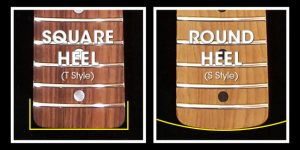
Fret Sizes
Fret size significantly impacts playability and tone. USACG offers a comprehensive selection of fret sizes to cater to every player’s preference. They use standard nickel silver alloy frets for a traditional feel and also offer stainless steel and gold EVO frets for enhanced durability and unique tonal characteristics.
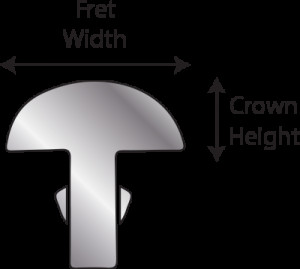
| Fret Size | Dimensions (w x h) | Description |
|---|---|---|
| 6230 | .080″ x .043″ | Vintage-style small wire for a classic feel, common on vintage instruments. |
| 6130 | .106″ x .036″ | Low and wide fret, providing ample fingerboard contact and a smooth playing surface. |
| 6105 | .090″ x .055″ | Tall and narrow – a versatile and popular all-purpose fret size, offering a balance of comfort and control. |
| 6125 | .095″ x .047″ | A medium-jumbo size, bridging the gap between 6105 and 6150, offering increased size without being overly large. |
| 6150 | .104″ x .047″ | True jumbo fret, favored by rock and bass players for enhanced bending and sustain. |
| 6100 | .110″ x .057″ | Huge fret wire, providing a scalloped feel and maximum note sustain, often preferred for shredding styles. |
| 6000 | .118″ x .058″ | “Railroad ties” – the largest fret size available, offering a dramatically scalloped feel and maximum string control. |
While stainless steel frets are known for their durability, some players believe they can alter tone. USACG acknowledges this, offering them as an option while still standing by the tonal qualities of traditional nickel silver frets, recognizing that player preference is paramount.
Nut Slot Specifications
The nut is a critical component affecting string spacing and action. USACG provides options for nut slot configurations to accommodate various nut types and player preferences.
- Curved or Flat Bottom: USACG can cut the nut slot with either a curved or flat bottom. Curved bottoms are recommended for fingerboards with a 7.25″ radius at the first fret to ensure proper nut seating.
- Locking Nut Compatibility: USACG can accommodate LSR roller nuts or Earvana OEM nuts at no extra charge. They also offer locking nut plateaus for Floyd Rose R2, R3, or R4 installations. USACG prefers top-mounted locking nuts to avoid stress on the neck caused by bolt-through designs.
- Neck Width Options:
- Guitar Necks: Choose from vintage 1.650″, modern 1.6875″, and wide 1.750″ nut widths to suit different playing styles and hand sizes.
- Bass Necks: Select between narrow “J bass” width or wider “P bass” width, catering to different bass playing preferences.
USACG does not sell or install pre-slotted nuts, emphasizing that nut fabrication and installation should be performed as one of the final steps in instrument assembly for a truly custom and precise fit. They recommend consulting with a qualified guitar tech or luthier for nut installation and can even recommend professionals in your area.
Truss Rod Adjustment
Truss rod adjustability is vital for maintaining optimal neck relief and playability. USACG offers both heel and peghead (top) adjustment options for their 2-piece construction necks. One-piece necks are exclusively available with heel adjust due to their construction.
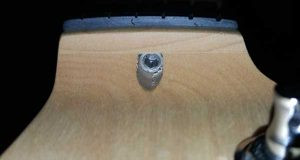
- Heel Adjust: A traditional truss rod adjustment located at the heel of the neck, often preferred for its classic aesthetic and robust design. Heel adjust truss rods on USACG necks utilize a durable stainless steel nut.
- Peghead Adjust (Top Adjust): Truss rod adjustment accessible from the peghead, offering convenient access for adjustments without removing the neck or strings. Peghead adjust truss rods require a 9/64″ hex wrench.
Inlay Options
Inlays add visual appeal and fretboard position markers. USACG offers a range of inlay options, from classic dots to premium shell materials and even Luminlay glow-in-the-dark inlays.
- Standard Dot Inlays: USACG uses standard 1/4″ dot inlays in black delrin, white plastic, or creamy faux clay for a traditional look. Smaller 3/32″ dots are also available for a more subtle appearance.
- Premium Shell Inlays: For a touch of elegance, choose premium shell inlays like Mother of Pearl, Black Mother of Pearl, or Paua Abalone Shell. These are available for face dots only or for both face and side dots.
- Luminlay Inlays: For enhanced visibility on dark stages, opt for Luminlay dots in Green or Blue, with white or black perimeters. Luminlay inlays are available for face dots, side dots, or both.
- No Inlay: For a minimalist aesthetic, you can choose to have no fingerboard inlays at all, though side dots are still recommended for position marking.
Fingerboard Radius
Fingerboard radius, the curvature of the fingerboard, significantly impacts playing comfort. USACG offers a wide variety of straight and compound radii to suit different playing styles.
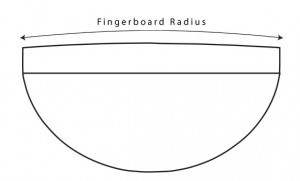
- Straight Radii:
- 7.25″: Vintage Fender radius, known for its comfortable feel for chording and vintage vibe.
- 9.5″: A slightly flatter radius, offering a good balance between chording comfort and bending ease.
- 10″, 12″, 16″: Increasingly flatter radii, favored for modern playing styles, fast action, and effortless bending.
- Compound Radii:
- 7.25″ – 9.5″: USACG’s most popular compound radius, combining vintage comfort in the lower frets with modern playability higher up the neck.
- 9.5″ – 12″, 10″ – 14″, 10″ – 16″, 12″ – 14″: Various compound radius options offering a gradual flattening of the fingerboard as you move up the neck, optimizing playability across the entire fretboard.
Neck Back Contours
The neck back contour, or shape, is a crucial factor in playing comfort and hand fatigue. USACG utilizes state-of-the-art CNC routing equipment to precisely shape their necks, offering a range of profiles to match individual preferences.
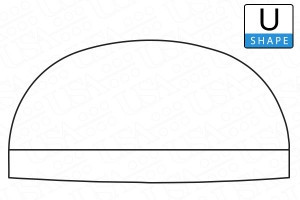
- Shapes: C, U, Asymmetrical, Super Soft V (SSV), and Medium V shapes are available. The Medium V shape offers a slightly less pronounced “V” than the Super Soft V. (Note: 12-string, 25″ scale conversion, and bass necks are only available in a C shape).
- Thickness: Neck thickness is measured from the front of the fingerboard to the back of the neck. USACG offers thicknesses ranging from .750″ to .900″ in .010″ increments. They use a standard .070″ taper from the 1st to the 12th fret, which they have found to be a comfortable and versatile taper. For super thin necks (.750″-.770″), graphite stabilizing bars are highly recommended (and required for warranty).
USACG also offers pre-programmed contours based on popular vintage neck profiles, simplifying the selection process for players seeking familiar shapes:
- Fatback: A substantial C shape with a consistent 1″ thickness and minimal taper.
- Boat Contour: A soft “V” shape with a 1″ thickness and some shoulder, reminiscent of a boat hull.
- Texas Blues: Asymmetrical shape with .860″ thickness at the 1st fret and a .070″ taper.
- Texas Blues Brother: A hard “V” shape transitioning to a “C” around the 9th fret, with a thickness of .830″-.850″ and a .070″ taper.
- Slow Hand: Medium “V” shape, around .860″-.870″ thick with a .070″ taper.
- The ’54: .850″ Soft “V” shape transitioning to a “C” with a more pronounced .090″+ taper.
- The ’63: A popular profile with a significant .130 taper, going from .830″ to .960″ thickness.
- E.B. Contour: Asymmetrical shape with .850″ thickness and a .070″ taper.
Peghead Shapes
The peghead shape contributes to the overall aesthetic of the guitar. USACG offers their own original peghead designs inspired by classic shapes, along with options for custom designs.
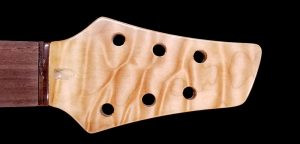
- Guitar Pegheads: US1, US2, US3, US4, 12 String, and Inline Paddlehead shapes are available.
- Bass Pegheads: USB-1 and USB-2 shapes are offered.
- Custom Peghead Shapes: USACG can create custom peghead shapes, either CNC-programmed for multiple orders or hand-cut for unique designs. Note that they will not produce copyright-protected peghead shapes.
Neck Woods
The choice of neck wood profoundly affects the guitar’s tone and stability. USACG uses only hand-selected, straight-grained woods with minimal runout. They primarily use cathedral cut blanks for added strength and stability.
- Hard Rock Maple: USACG’s most popular choice, used for approximately 90% of their necks. Maple is known for its durability, brightness, and articulate tone. Available in various cuts including Quartersawn, Birdseye, and Flame.
- Roasted Maple: Rock maple that has been heat-treated to reduce moisture content, enhance stability, and create a rich caramel color. Roasted maple necks are exceptionally stable in varying climates and offer a unique aesthetic. Available in plain and figured varieties.
- Mahogany: African and equatorial mahogany are used for their warm, resonant tone. Mahogany necks can be paired with mahogany bodies for a rich, full sound or with swamp ash bodies to balance out brighter tones.
- Rosewood: Indian and Brazilian rosewood (when available) are used for fingerboards. Rosewood is oily and porous, dampening high frequencies and creating a smoother, warmer tone, ideal for blues, jazz, and rock.
- Pau Ferro: An excellent alternative to rosewood, particularly for international customers. Pau Ferro exhibits a nice grain and ranges from chocolate to tan in color. It’s harder than rosewood, making it suitable for fretless basses, and offers a tone that is less bright than ebony.
- Ebony: A very hard and dense wood, available in jet black and striped Macassar versions. Ebony fingerboards add brightness and sustain, making them suitable for players seeking a cutting tone, particularly in rock and metal genres. Ebony also enhances articulation on mahogany or hollow bodies that may be naturally warmer in tone.
Neck Pricing and Value
USACG custom guitar necks are positioned as premium components, reflecting the superior quality, meticulous craftsmanship, and extensive customization options they offer. While not the cheapest option on the market, they represent exceptional value for players who prioritize quality, playability, and tone.
Base prices are as follows (additional charges apply for wood choices, fret materials, inlays, and other custom options):
- Two-piece construction maple guitar neck: $210
- One-piece construction maple guitar neck: $215
- 4-string two-piece construction maple bass neck: $260
For detailed pricing information, please refer to the USACG Neck Pricing page.
Conclusion
Investing in a custom guitar neck from USACG is an investment in your playing experience. The vast array of customizable options ensures you can create a neck that is perfectly tailored to your hand, playing style, and tonal preferences. From meticulously crafted features to a wide selection of woods, shapes, and sizes, USACG empowers you to design a neck that will elevate your guitar and inspire your music for years to come.
Don’t settle for a generic neck. Design your dream neck today!
See Neck Inventory
Build your custom neck now
